
Peace Magazine Jul-Sep 2021, page 27. Some rights reserved.
Search for other articles by Trudy Govier (reviewer) here
The Frontlines of Peace: An Insider’s Guide to Changing the World
By Severine Autesserre, Oxford; Oxford University Press, 2021
This stimulating book should provoke important discussions about approaches to peacebuilding. Many peacebuilding efforts have produced disappointing results, which often receive attention. A problematic aspect of this negative focus is the lack of attention to cases of success. Severine Autesserre recounts her work in Kosovo, the Democratic Republic of Congo, Somaliland, Kenya, Colombia, and elsewhere. She is a widely experienced worker, author, and professor (Barnard College, Columbia University). Autesserre tells of successes and failures, ably exploiting her considerable experience and wide range of engaged contacts. The successes are cases in which determined local people have employed energy and understanding to curb violence in their communities. The failures are cases in which outsiders (intervenors from the United Nations and various humanitarian agencies) work in a top-down fashion, typically with little historical, cultural, or linguistic knowledge relevant to a specific location.
Pictures of leaders shaking hands misrepresent the nature and success of peacebuilding. What matters is the local level: peace requires a culture in which conflicts are handled without recourse to violence. Leaders’ agree ments based on international knowledge and norms cannot guarantee to local communities peace in this sense. Success is to be sought and found at the local level. The fascinating examples described include those of Idjwi, an island in the Congo; the Ruziza plain, in that same country; San Josť de Arpatado, a small and restricted community in Colombia; Somaliland, a country north of Somalia; and Wahat -al-Salam/Neve Shalom, a village demonstrating that Israeli Jews and Muslim and Christian Palestinians can live peacefully together. In each of these places, despite many challenges, the sustained efforts of local people have led to increased safety and a dramatic lessening of violence.
Can there be peace without justice? In Idjwi there is discrimination against pygmies. In Somaliland, against women. In San Josť de Arpatado, against any and all outsiders. Yet inhabitants of these places enjoy peace in the sense of personal security against violence. Who is to decide whether such peace is worth its name? If there is a conflict of values, who should make the choice? Academics have agonized about such questions: for Autesserre the answer is obvious: the people affected.
What about human rights? Elections as the basis for democratic government? Cultural and historical backing are needed; these practices will not work in their absence. Even where the backing is absent, local people can benefit from the elimination of violence and work to achieve it. They can be successful. We know that, because some have.
In her emphasis on the local, Autesserre is highly critical of the practices and policies of international outsiders. She refers to them pejoratively (and unfortunately) as “Peace Inc.” and “Peaceland.” People—and she was one—qualified with master’s degrees and generalized training about conflict—are placed in countries where they lack experience and knowledge, and urged to do conflict analysis pretty quickly so as to achieve top-down resolutions.
This approach is castigated, even mocked, in the book. But there is a “now you say it, now you take it back” approach on this crucial matter.
Ultimately (see pages 168-173) the author allows that both top-down and bottom-up processes are needed. It turns out that outsiders can further local efforts in various ways. The list is quite long: bring funding, ideas, high level connections and experience from other places; help negotiate international bureaucracy; deter some abuses including those of corruption and nepotism; and show that outsiders care.
Outsiders should not work only from the top. They should listen and engage with local communities; they should seek to prevent violence, not just treat its baneful effects. They should care. And despite the pitfalls, they do. Top-down and bottom-up need to be fitted together.
Reviewed by Trudy Govier, emerita professor of philosophy, University of Lethbridge; current president, Ploughshares Calgary Society.

Peace Magazine Jul-Sep 2021, page 27. Some rights reserved.
Search for other articles by Trudy Govier (reviewer) here